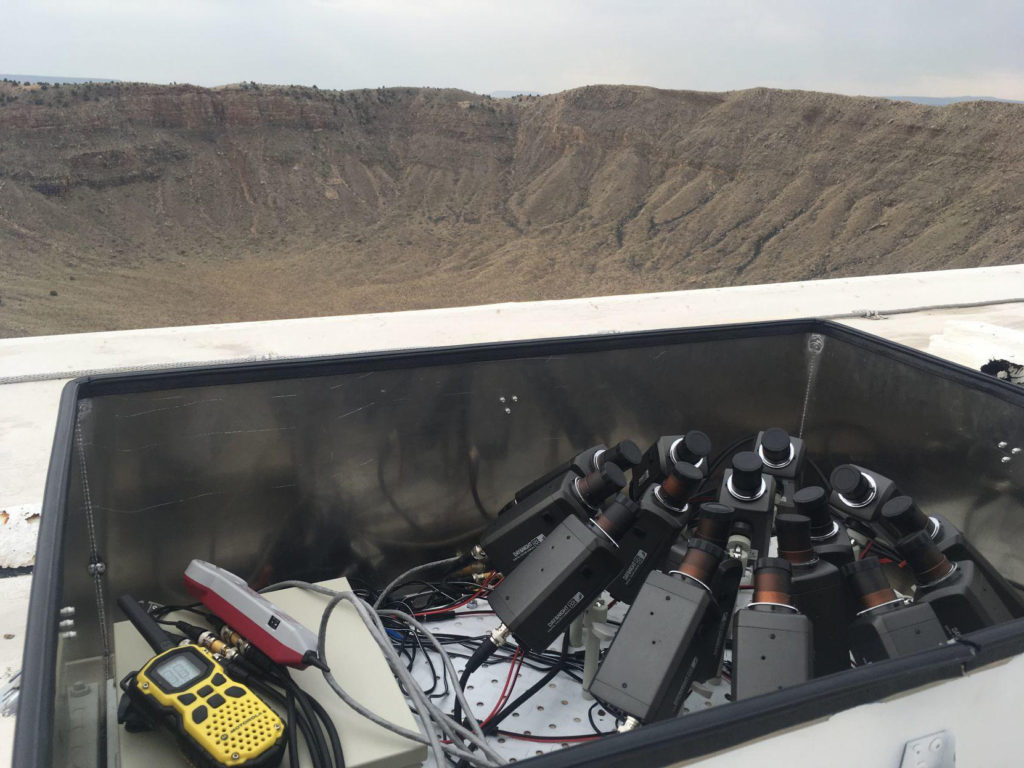
Nick Moskovitz helps to operate a network of video cameras called LO-CAMS (the Lowell Observatory Cameras for All-sky Meteor Surveillance). LO-CAMS is based on a concept originally developed by collaborator Peter Jenniskens from the SETI Institute in Mountain View, CA, and employs an array of 16 off-the-shelf security cameras to autonomously record a mosaic view of the night sky at 30 frames per second. Approximately 50 GB of video data are recorded each night, which are processed by software to search for meteors.
In June of 2016 LO-CAMS consisted of two stations, one located on the roof of the Slipher building on Mars Hill and one connected to the auxiliary building at the Lowell Discovery Telescope. Both stations detected a June 2 event in eatern Arizona which enabled triangulation of the meteor trajectory. This revealed that the meteoroid impacted Earth’s atmosphere at a velocity of about 16 km/s (37,000 mph) and was luminous from an altitude of 107 to 77 km (66 – 48 miles). This trajectory additionally suggested that before impact the meteoroid was on an orbit around the Sun that originated from the inner edge of the main asteroid belt between Mars and Jupiter.
Analysis of these LO-CAMS data as well as additional video from dashboard cameras and publicly available Doppler weather radar data from the National Weather Service (data that are uniquely well suited to detect particles falling through the atmosphere), suggested a likely meteorite fall around 4:00 am near a remote community called Cibecue on the White Mountain Apache Reservation. The prospect of fresh meteorites on the ground initiated discussions with tribal elders to obtain permission for a small group of scientists from Arizona State University to search the possible fall location. After a number of days in difficult search terrain under central Arizona June temperatures, 23 small meteorites were recovered. Based on the suggestion of White Mountain Apache Tribe members, these meteorites have been officially named Dishchii’bikoh Ts’iłsǫǫsé Tsee, which in the Apache language means, “Cibecue Star Stone” (Dishchii’bikoh = Cibecue, Ts’iłsǫǫsé Tsee = star stone).
With meteorites in hand, and numerous observations of the meteor, all pieces were in place to fully characterize this rare event. The Dishchii’bikoh impactor is now believed to have originated from the Flora asteroid family in the Main belt, the same point of origin of the well-known 20-meter impactor that landed over the city of Chelyabinsk, Russia in February 2013. Both Chelyabinsk and Dishchii’bikoh have been classified as LL-chondrites, a relatively common meteorite type that represent about 10% of all meteorite falls, and are respectively only the third and fourth LL-chondrites to ever be recorded as meteors entering the atmosphere. The impactor itself was likely around 80 cm (3 feet) in size before impact, which makes this a relatively rare event that is only expected to occur for an object of this size once every decade or so over the state of Arizona.
All told the combination of data collected on the Dishchii’bikoh event highlights the power of large integrated data sets that include on-sky observations, public databases, citizen reports, and laboratory analyses. Since 2016 Moskovitz and collaborators have deployed additional camera stations at Embry-Riddle Aeronautical University in Prescott, AZ and Meteor Crater outside of Winslow, AZ.